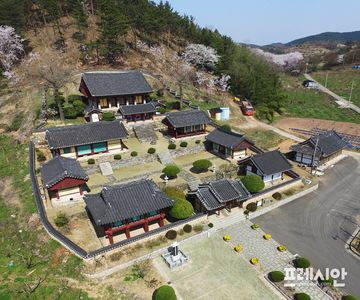사천향교
| 사천향교 Sacheonhyanggyo Local Confucian School |
|
 “사천향교, 향교문화체험 프로그램 실시”, 프레시안, 2019.07.02. |
|
| 대표명칭 | 사천향교 |
|---|---|
| 영문명칭 | Sacheonhyanggyo Local Confucian School |
| 한자 | 泗川鄕校 |
| 주소 | 경상남도 사천시 사천읍 사천향교로 25 |
| 지정(등록) 종목 | 시도유형문화재 제220호 |
| 지정(등록)일 | 1983년 8월 12일 |
| 분류 | 유적건조물/교육문화/교육기관/향교 |
| 시대 | 조선시대 |
| 수량/면적 | 일원 |
| 웹사이트 | 사천향교, 국가문화유산포털, 문화재청. |
|
|
|
해설문
국문
향교는 공자, 공자의 제자, 공자의 가르침을 따랐던 뛰어난 학자들을 받들면서 그들이 쓴 책, 말, 행동을 따르도록 젊은이들을 교육시키는 지방 교육 기관이다.
사천향교는 세종 3년(1421)에 향학당(鄕學堂)으로 시작하여 임진왜란 등을 겪으면서 여러 번 불에 타 고쳐 지었다.
사천향교는 경사진 언덕에 지어졌으며 향교의 교육 공간인 명륜당(明倫堂)을 앞쪽에 두고 제사를 지내는 공간인 대성전(大成殿)을 뒤쪽에 두었다.
지금의 사천향교는 다른 지역의 향교와 조금은 다른 모습이다. 향교의 누각인 풍화루(風化樓)는 학생의 휴식 공간이자 출입문으로서의 역할을 하는데 지금은 담 안에 있다. 또한 대성전과 일직선에 있어야 할 명륜당이 한쪽으로 비켜 있다. 대성전은 앞면 5칸, 옆면 2칸으로 다른 향교에 비해 규모가 크다.
사천향교는 경사가 큰 장소에 여러 채의 건물을 세우고 시간의 흐름에 따라 적절하게 변형하고 고쳐 지은 점에서 가치가 있다.
영문
Sacheonhyanggyo Local Confucian School
Local Confucian schools, called hyanggyo in Korean, are public education institutions of the Goryeo (918-1392) and Joseon (1392-1910) periods. They were established nationwide to function as local shrines for Confucius and other sages and to promote Confucian education and nurture elites in local districts. Students learned about literature including poetry composition, Confucian Classics, and history.
This local Confucian school was first established in 1421 as a village study hall in today's Pungjeong-ri Village, about 2 km away from its current location. It was burned down during the Japanese invasions (1592-1598) and rebuilt in 1645 at its current location. Since then, it underwent several reconstructions.
The complex, from front to back, includes a main gate, a gate pavilion called Punghwaru, two dormitories, a lecture hall called Myeongnyundang, an inner gate, and a main shrine called Daeseongjeon. The gate pavilion building once served as the main gate but is now located inside the complex, to the left of the more newly built main gate. Generally, in a local Confucian school complex, a lecture hall and a main shrine are aligned one in front of the other, but here, the lecture hall is situated to the left. Such changes in the layout can be explained as a result of the numerous reconstructions and renovations Sacheonhyanggyo underwent over its history.
- Just a general curiosity: when we say “there is a lecture hall called Myeongnyundang” without additional explanation is there a chance people would think that Myeongnyundang is the name of this specific lecture hall only?
- When was the main gate built? Is it safe to say "more newly built?"
영문 해설 내용
향교는 고려시대와 조선시대 지방에서 유학을 교육하기 위하여 설립된 국립교육기관이다. 덕행과 학문의 모범을 보인 성현에게 제사를 올리며, 유교의 경전과 역사, 시나 문장을 짓는 법을 가르쳤다.
이 향교는 1421년 지금의 정동읍 풍정리에 마을 학당으로 처음 지어졌던 것으로 추정된다. 임진왜란으로 학당이 소실된 후, 1645년 현재의 위치로 옮겨서 새로 지었으며, 이후 여러 차례 중수되었다.
사천향교는, 앞쪽에서부터, 정문, 풍화루, 기숙사인 동재와 서재, 강당인 명륜당, 내삼문, 대성전 등으로 이루어져 있다. 풍화루는 원래 정문으로 쓰던 문루이지만, 지금은 담 안에 있다. 또한 향교에서 명륜당과 대성전은 일직선상에 놓이는 것이 일반적이지만, 여기서는 명륜당이 한쪽으로 비켜있다. 이러한 배치는 사천향교가 오랜 기간에 걸쳐 중수와 보수를 계속하면서 변형된 것이다.
갤러리
참고
- “사천향교, 향교문화체험 프로그램 실시”, 프레시안, 2019.07.02.
- 국립문화재연구소, 「사천향교」, 『경상남도의 향교건축 2』, 2004, 198쪽.
